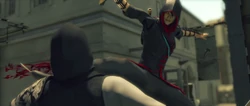- "The Wall will protect the people. And so shall we."
- ―Shao Jun, 1567[src]
The Chinese Brotherhood of Assassins, also known at various points as the Beijing Brotherhood,[1] is the branch of the Assassin Brotherhood in China, one of the few to have existed for more than a thousand years. Like other divisions throughout the world, it operated as an Assassin Guild from the time of Altaïr Ibn-La'Ahad's reforms until that system was superseded in the 20th century by that of decentralized cells.
Throughout imperial history, the Chinese Assassins were responsible for countering the atrocities perpetrated by emperors aligned with the Templars. In light of this, they were behind the assassinations of notable rulers such as Qin Shi Huang, the Yongle Emperor, and the Jiajing Emperor. Under the Song dynasty, they partook in the defense of the nation from the Mongol Empire, personally slaying the Great Khan Möngke Khan although they would ultimately fail to save it from conquest under Kublai Khan.
The Brotherhood's long history, paralleling that of the nation it represents, is marked by major fluctuations in its fortunes as it battled their Templar counterpart, the Chinese Rite. During the Ming dynasty, they were the frequent target of purges enacted by the government in concert with the Templars. Most infamously, the Great Rites Controversy during the reign of the Jiajing Emperor exterminated the guild down to a lone Assassin: Shao Jun. Despite these calamities, the Chinese Brotherhood has endured, with Jun restoring the branch after eliminating each of the leading Templars responsible for the purge.
History
Qin dynasty
In 221 BCE, Zhao Zheng, supported by proto-Templars, unified China under his banner and became the first Emperor of Imperial China, proclaiming himself Qin Shi Huangdi and starting the Qin dynasty.[2] His tyrannical reign lasted only a decade because in 210 BCE,[3] a man named Wei Yu slew him with a spear. For this deed, which predated the founding of the Assassin Brotherhood,[4] Wei Yu was later immortalized by the Assassins.[5]
Song dynasty
During the Song dynasty (960–1279), China had to contend with the onslaught of the Mongol Empire. Fearing the devastation that the Mongols would wrought, Assassins throughout Asia actively sought to halt their advances. Genghis Khan, the founder of the Mongol Empire, was slain by the Mongol Assassin Qulan Gal at Xingqing, capital of the nearby Xia Empire in 1227, but this only forestalled China's fall to the Mongols.[6]
The conflict dragged on for the next few decades with the Song's grasp on the country continuing to crumble before the might of the Mongol forces. In 1259, a Chinese Assassin perished in the midst of saving Diaoyu Fortress from a Mongol assault, leaving his daughter, Zhang Zhi, to discover his corpse in the aftermath. Despite his doubts about her motives, Kang, the late Assassin's Mentor, acquiesced to adopting Zhi into the order and completing her training. His misgivings were proven true when Zhi defied his warnings to prioritize duty over revenge and personally infiltrated the Mongol camp to assassinate the Great Khan Möngke Khan. Though she was successful, she was crippled during her escape by the future Templar Bayan, and Kang used her disability as an added pretext for expelling her from the order.[7]
Ming dynasty
Yongle era purge

Li Tong and an apprentice escaping the purge
By the early 15th century, the Chinese Assassins were led by the Mentor Fang Xiaoru. In 1402, the imperial throne was usurped by Zhu Di with the help of the Templars. Under Zhu Di's reign as the Yongle Emperor, thousands of Assassins were rounded up and executed, including Fang Xiaoru. However, two Assassins, a young female named Li Tong and another apprentice, were able to escape the purge with an Apple of Eden. Li devoted herself to protecting the Apple and keeping it out of the Yongle Emperor's hands.[8]
In 1424, while the Yongle Emperor was preoccupied with the suppression of a rebellion near the Gobi Desert, Li Tong slipped into the Emperor's tent and assassinated him.[8]
Fall of the Brotherhood
The Yongle Emperor would not be the last Ming emperor to align with Templar interests. Periodically, the Assassins and Templar continued to vie for influence in the imperial court from behind the scenes. In 1506 during the reign of the Zhengde Emperor, the Master Assassin Wang Yangming was banished from the capital of Beijing by Liu Jin, a powerful eunuch. Though Liu Jin was the leader of the Eight Tigers, a group of corrupt eunuchs composed of Templars, the Templars at this time failed to deduce Yangming's true allegiances, believing him to be merely a Neo-Confucian philosopher.[1]
In 1510, the Assassins staged the Prince of Anhua rebellion named after Zhu Zhifan, the Prince of Anhua, but with Templar assistance, Liu Jin was perfectly poised to defeat it. Jin was soon afterwards implicated in treason by another Tiger Zhang Yong and summarily executed by the Zhengde Emperor as part of a plot by Zhang Yong to seize leadership of their group. A decade of respite for the Assassins seemed to follow, as the Tigers decided to play their hands carefully and bide their time after Jin's execution.[1]
In 1521, upon the death of the Zhengde Emperor, the government was weakened by the ensuing succession dispute. The Templars saw this distraction as an opportunity to destroy the Assassins, but a former concubine of the late emperor, Shao Jun, having discovered the shadow war on her own, managed to warn Wang Yangming of the surprise operation. Acting swiftly, Yangming led the Assassins in a preemptive strike on the Templars in the Forbidden City, but in spite of the presence of his best agents, they were routed.[1]
Capitalizing on this critical victory, the Templars used the momentum to enact a city-wide purge, capturing and executing many Assassins, their associates, and any innocents with tangential ties to them. In the wake of this disaster, Wang Yangming ordered the Chinese Brotherhood, along with all their allies, to withdraw from Beijing entirely, regrouping at Maijishan Grottoes. Jun was thus spirited away with the Assassins for training. In the meantime, the Templars managed to install their own puppet, Zhu Houcong, as the new Jiajing Emperor.[1]
Three years later, under the machinations of the Templars, the Jiajing Emperor triggered what became known as the Great Rites Controversy, where he had his father declared emperor posthumously, defying expectations to maintain an unbroken line of succession. The Great Rites Controversy became a pretext for the Jiajing Emperor to purge dissidents and the medium through which the Templars could eradicate their mortal enemies. Across the nation, Assassin safehouses were raided by the Templars, with even the headquarters at Maijishan Grottoes falling to a Templar assault. Yangming, well-known to the Templars by then as the Assassin Mentor, retreated into hiding and handed leadership over to Zhu Jiuyuan.[1]
With virtually every Assassin worthy of the name dead save Wang Yangming, Zhu Jiuyuan, and Shao Jun, the Brotherhood was all but exterminated and the Templars had total control over the country. Not even knowing if Yangming was still alive, Jiuyuan and Jun decided that their only recourse was to seek help from Assassins abroad, specifically the legendary Ezio Auditore da Firenze of the Italian Brotherhood. Dogged by Templars every step of their journey, Jiuyuan was finally slain by their agents in Venice, but Shao Jun survived and successfully made contact with Ezio at his villa in Tuscany.[1]

Shao Jun and Ezio Auditore, before her departure
Though the elderly former Mentor was initially reluctant to teach Jun, as she represented everything he had sworn to set aside when he settled down, he eventually relented and completed her training. Before she left for her journey home, Ezio presented her with a Precursor box as a parting gift to be opened only in a times of dire need.[1][9]
Restoration
- "A new tomorrow for China and its people. I will undo all that you have done. I will rebuild the Brotherhood and recruit those who wish to make our land a place of freedom, those ready to die to fight men like you. Your Templar world will not happen. The Assassins will rise again."
- ―Shao Jun to a dying Zhang Yong, 1532[src]
Upon her return to China in 1526, Jun tracked down Wang Yangming through a network of old, abandoned Assassin safehouses. After sharing with him the events that transpired in her mission to Italy, the two agreed that their predicament merited opening the box, only to find it empty. Determining that perhaps the Templars would understand its function, Yangming decided that their first plan would be to use it as a bait to lure the Templars out of hiding.[1]
Thus, Shao Jun's quest for vengeance began by having herself captured by the Tiger Gao Feng at Maijishan Grottoes—by then converted into a Templar dungeon—in the hopes that his interrogation would reveal what the Templars knew of the box. When this plan proved fruitless, Jun wasted no time in escaping from her cell and assassinating Feng, but by then, he had already secreted the box away to his allies. Erstwhile, Yangming had managed to eliminate another Tiger, Ma Yongcheng.[1]
Before the year was out, Yangming had located the Templar in possession of the box: Yu Dayong, a Tiger that operated a slave trade in Macau. Accordingly, Jun infiltrated Dayong's fortress, slew him, and retrieved the box, but in retaliation his compatriot Qiu Ju set all of Macau ablaze. The Assassin escaped the inferno, and three years later in 1529, she and Yangming traveled to Nan'an in search of the Tigers' leader Zhang Yong. There, they hoped that in the process of assassinating Yong's lieutenant, Wei Bin, they might also happen to wring Yong's location out of him. Unbeknownst to them, Yangming himself was being hunted by Yong at that very moment. Jun learned of this belatedly upon killing Bin at his stronghold, and she returned to her mentor too late to stop his death at Yong's hands. Though she survived the ensuing ambush, she was unable to stop Yong from snatching the box back from Yangming's corpse.[1]
The following year, Jun was lured to the Forbidden City by Empress Zhang, her childhood friend who under Templar coercion had lied that she had information on Zhang Yong's whereabouts. Meeting with the Empress, Jun walked into a trap set by Yong and Ju. The former departed to allow his subordinate to deal with Jun personally, but a fire broke out when the lantern of a guard was shot by a hand cannon in the fight that followed. In short order, the Forbidden City was engulfed in flames. Jun slew Ju in personal combat before fleeing the burning palace.[1]
In 1532, Jun arrived at the Great Wall of China upon discovering Yong's conspiracy to allow the Mongols of Altan Khan into China. Well aware that Yong had fed the Mongolian scouts details of China's defenses, Jun assassinated all four of the scouts who had access to this intel before confronting Yong himself. Their engagement was interrupted by a sudden all-out assault by the Mongolians on the Great Wall, for upon discovering the deaths of the deaths of their scouts, they believed that Yong had betrayed their deal. In the midst of this onslaught, Yong fled from Jun, but he failed to lose the Assassin and was finally killed. Even so, because he had already sent the box away to Templars outside China, Jun could not immediately recover it.[1]

A Chinese Assassin reporting to the Mentor Shao Jun
With the last of the Eight Tigers dead, Jun capitalized on her victory and revived the Chinese Brotherhood. By 1567, she still served as the guild's Mentor, and that year, she ordered the assassination of the Jiajing Emperor by poisoning him with a false elixir of life. The mission succeeded, with the agent who conducted it returning to Jun at the Great Wall to personally report the Emperor's death.[1]
Even at this point late in her life, however, Jun still had not learned the function of Ezio's Precursor box, but her Brotherhood did succeed in recovering it. After her death, the box remained in their possession for about a century before eventually smuggling it to the West Indies Brotherhood via Manila galleons.[10]
Qing dynasty
By the early 18th century, the Chinese Brotherhood was still strong, as Ah Tabai, Mentor of the West Indies Brotherhood, possessed contacts as far as China. [11]
Republic era
In 1925, the Assassins were behind the death of Sun Yat-sen, then the Templar Grand Master of the Shanghai Rite.[12] China by then had fractured into warlordism, and in the wake of the Chinese Civil War, the Chinese Brotherhood lost the nation to the Templars under the leadership of Mao Zedong.[13]
By 2015, at least one Assassin cell operated in China. That year, they were aided by the Japanese Assassins, including Kiyoshi Takakura, who were sent by Japanese Mentor Saeko Mochizuki, in their search for Álvaro Gramática's secret laboratory in which he planned to replicate an Isu's body with the help of the Shroud.[14]
In 2016, the Chinese Assassin Yanmei was ordered by Assassin leader Gavin Banks to assist another Assassin, Griffin, and the teenagers Natalya Aliyev, David Collins and Javier Mondragón in finding the Tomb of Möngke Khan and retrieving a prong of the Trident of Eden. However, Yanmei was ultimately killed by the Templar Isaiah after he recovered the fear prong and used its power against everyone, killing her when she tried to attack him.[7]
In February 2017, an Assassin cell led by Barindra Mitra assisted Charlotte de la Cruz in her efforts to gather information about the Templars' Phoenix Project. Infiltrating an office of Abstergo in a skyscraper in Hong Kong, which had in fact been abandoned by the Templars, the Assassins were ambushed by an unidentified group. Barindra and her cell were all killed with only Charlotte and the tech expert, Guernica Moneo, escaping.[15]
Techniques and equipment
True to their heritage, the Chinese Assassins blended Assassin techniques with traditional Chinese martial arts. As a result, their combat maneuvers were more acrobatic and employed more footwork.[1][9] Though the Hidden Blade, the iconic weapon of the Assassins, was standard for the Chinese Brotherhood, Shao Jun was displeased with it and created her own variant more suited to her style: the Hidden Footblade which extended from her foot rather than her wrist.[1] This complemented her agile fighting style which had a special emphasis on kicks.[1][9]

Shao Jun using her concealed blade
Aside from this, in 1526, Jun also invented the rope dart which she utilized as a grappling hook and to extend the reach of her assassinations.[1] Use of this weapon would later spread to other guilds such as the Colonial Brotherhood in the 18th century.[16] Other gadgets in their arsenal included firecrackers which similar to smoke bombs served to momentarily stun enemies, noise darts which emitted sounds that were useful for distracting enemies, throwing knives,[1] and bracers that launched needles.[9]
Attire
Unlike the standard white and red color scheme of Assassin robes, the outfit of Shao Jun was black and red.[1][9] Nevertheless, at least one of her agents donned white robes with red trims consistent with the traditional Assassin colors.[1] On many occasions, Chinese Assassins wore ordinary Chinese clothing, making their affiliation hardly recognizable.[5][8]
Members
Qin Dynasty
Song Dynasty
Ming Dynasty
Republic Era
- Barindra Mitra (Membership uncertain)
- Yanmei
Allies and puppets
Ming dynasty
Qing dynasty
Republic era
Appearances
- Assassin's Creed: Revelations – Discover Your Legacy
- Assassin's Creed: Embers
- Assassin's Creed Chronicles: China
- Assassin's Creed: Last Descendants – Tomb of the Khan
- Assassin's Creed: Syndicate (mentioned only)
References
- ↑ 1.00 1.01 1.02 1.03 1.04 1.05 1.06 1.07 1.08 1.09 1.10 1.11 1.12 1.13 1.14 1.15 1.16 1.17 1.18 1.19 1.20 Assassin's Creed Chronicles: China
- ↑ Assassin's Creed Encyclopedia
- ↑ Assassin's Creed: Initiates
- ↑ Assassin's Creed: Origins
- ↑ 5.0 5.1 Assassin's Creed II
- ↑ Assassin's Creed: The Secret Crusade
- ↑ 7.0 7.1 Assassin's Creed: Last Descendants - Tomb of the Khan
- ↑ 8.0 8.1 8.2 Assassin's Creed: Revelations – Discover Your Legacy
- ↑ 9.0 9.1 9.2 9.3 9.4 Assassin's Creed: Embers
- ↑ Assassin's Creed: Rogue – War Letters
- ↑ Assassin's Creed IV: Black Flag
- ↑ Assassin's Creed: Templars – Black Cross #002
- ↑ Assassin's Creed: Brotherhood – Rifts: Cluster 10
- ↑ Assassin's Creed: Syndicate – Database: Assassin Intel 4
- ↑ Assassin's Creed: Uprising – Volume 1
- ↑ Assassin's Creed III
| |||||||||||||||||||||||||||||||
| ||||||||||||||||||||||||||||
| |||||||||||||||||||||||||||||||


